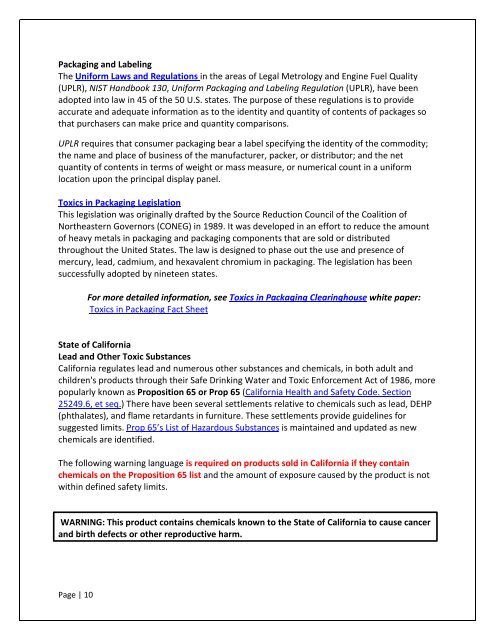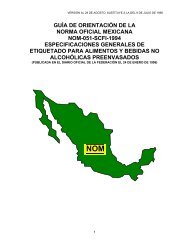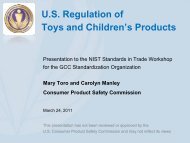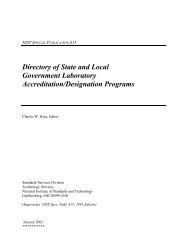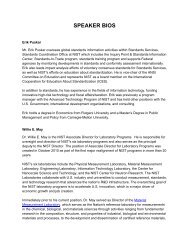Footwear Compliance Requirements - NIST Global Standards ...
Footwear Compliance Requirements - NIST Global Standards ...
Footwear Compliance Requirements - NIST Global Standards ...
You also want an ePaper? Increase the reach of your titles
YUMPU automatically turns print PDFs into web optimized ePapers that Google loves.
Packaging and Labeling<br />
The Uniform Laws and Regulations in the areas of Legal Metrology and Engine Fuel Quality<br />
(UPLR), <strong>NIST</strong> Handbook 130, Uniform Packaging and Labeling Regulation (UPLR), have been<br />
adopted into law in 45 of the 50 U.S. states. The purpose of these regulations is to provide<br />
accurate and adequate information as to the identity and quantity of contents of packages so<br />
that purchasers can make price and quantity comparisons.<br />
UPLR requires that consumer packaging bear a label specifying the identity of the commodity;<br />
the name and place of business of the manufacturer, packer, or distributor; and the net<br />
quantity of contents in terms of weight or mass measure, or numerical count in a uniform<br />
location upon the principal display panel.<br />
Toxics in Packaging Legislation<br />
This legislation was originally drafted by the Source Reduction Council of the Coalition of<br />
Northeastern Governors (CONEG) in 1989. It was developed in an effort to reduce the amount<br />
of heavy metals in packaging and packaging components that are sold or distributed<br />
throughout the United States. The law is designed to phase out the use and presence of<br />
mercury, lead, cadmium, and hexavalent chromium in packaging. The legislation has been<br />
successfully adopted by nineteen states.<br />
Page | 10<br />
For more detailed information, see Toxics in Packaging Clearinghouse white paper:<br />
Toxics in Packaging Fact Sheet<br />
State of California<br />
Lead and Other Toxic Substances<br />
California regulates lead and numerous other substances and chemicals, in both adult and<br />
children's products through their Safe Drinking Water and Toxic Enforcement Act of 1986, more<br />
popularly known as Proposition 65 or Prop 65 (California Health and Safety Code. Section<br />
25249.6, et seq.) There have been several settlements relative to chemicals such as lead, DEHP<br />
(phthalates), and flame retardants in furniture. These settlements provide guidelines for<br />
suggested limits. Prop 65’s List of Hazardous Substances is maintained and updated as new<br />
chemicals are identified.<br />
The following warning language is required on products sold in California if they contain<br />
chemicals on the Proposition 65 list and the amount of exposure caused by the product is not<br />
within defined safety limits.<br />
WARNING: This product contains chemicals known to the State of California to cause cancer<br />
and birth defects or other reproductive harm.


